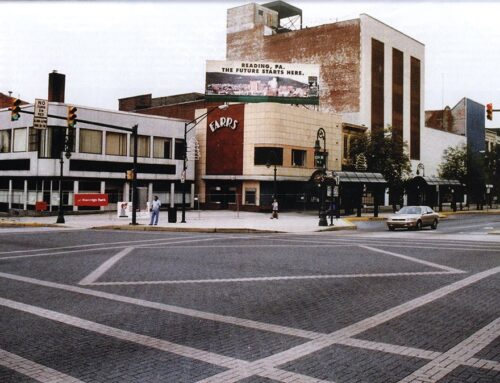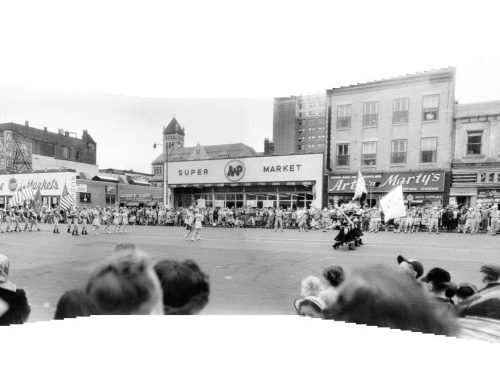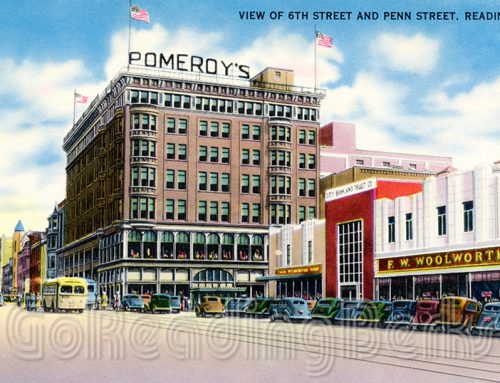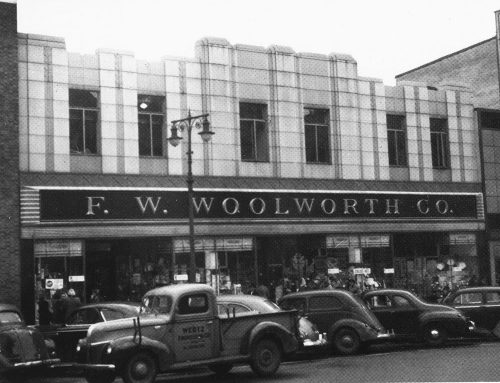In the 1870s, three young men, salesmen for Brown, Thomson and McWhirter, at Hartford, Conn., had a dream. They dreamed the dream of every ambitious youth that of owning a business establishment of which they might be proud of. They had only a few years of experience in retail trade, practically no resources or financial backing but plenty of confidence and undaunted courage.
The oldest of the trio was Josiah Dives. He was born in historic Canterbury, England and educated in the schools of the town and Cross academy. The death of his father when he was 13 led him to seek his fortune in London where he became a salesman at Debenham and Freebody. It was here that Mr. Thomson of Hartford met him and persuaded him to relocate to Connecticut.
The second and youngest of the trio was George Strickland Pomeroy. George Strickland Pomeroy, was born on July 10, 1853, in the city of Hartford, Connecticut. He was the son of Joseph and Mary Wadsworth Pomeroy. His family ancestors were Colonial and Continental. In the paternal line his ancestor, Joseph Pomeroy, was one of the Minute Men of Connecticut who rallied to the support of Massachusetts during the Lexington alarm, in April, 1775. In the maternal line, Thomas Wadsworth was a sergeant and his wife the daughter of John Arnold, of Col. Israel Putnam’s Connecticut men, who stood by their guns at Bunker Hill until the last round of ammunition was fired, and then crossed bayonets with the storming veterans of King George IV.
Mr. Pomeroy illustrated in his life the highest qualities of a self-made man. He sprang from a line of noted merchants of Bristol, England, who came to America during the earliest decades of colonization in Massachusetts Bay. He had the childhood and youthful guidance and training of exemplary parents. He was carefully educated in the public and later in a private school in his native city, and finished his course of intellectual equipment under Rev. Mr. Noble at his school for boys at Brookfield. He was fond of music. He also indulged in the usual sports of baseball and other youthful athletic diversions.
An early desire to feel independence of paternal care and support led him, when still young, to a window notice, “Boy wanted,” in the establishment of Brown, Thomson, and McWhirter. In this field young Pomeroy was not slow in exhibiting his exceptional qualifications. As a reward of merit he was soon placed at the head of a department. At this time he was 23 years old. While there he met his future partners, Josiah Dives, of Canterbury, England, and John Stewart, of Edinburgh, Scotland.
Outside of his daily duties at the store George Pomeroy was a thoughtful and helpful son and brother, a characteristic which grew and strengthened with his manhood. He also became interested in good works for society in general. For some years, until he left the city of his birth to seek his fortune, he was an active usher in the Church of the Good Shepherd and was Librarian in the Sabbath-school.
The third of the associates was Johh Stewart, born in Edinburgh, Scotland on the 22d of June, 1852. He sprang from the best blood of Perthshire, the region which divides the highlands and lowlands of Scotland. His father, George Robert Stewart, was the son of Donald Stewart, of the Stewarts of Garth and Drumacharry, and Elizabeth Robertson, the daughter of Neil Robertson, nephew of Robertson of Struan. Both families were of remote lineage and famous in scenes of peace and war. In the majestic Grampians, one of the three major mountain ranges in Scotland, occupying a considerable portion of the Scottish Highlands in northeast Scotland, they fed their flocks of sheep amid their herds of black cattle in the luxuriant valleys. He, too had sailed shortly after reaching his maturity, to Hartford where many of his countrymen had located. He was then 24 years old.
Dives, Pomeroy, and Stewart had become acquainted in the course of their daily duties and it was not long before they cherished a common desire for developing a business of their own. The determination was there, only a location must now be settled.
A Hartford merchant had mentioned to Mr. Pomeroy that a small town in Pennsylvania named Reading offered a promising outlook to progressive merchants. Mr. Dives and Mr. Pomeroy came to Reading in the early 1870s to make a study of the situation. What they saw was a small city of about 40,000 residents still struggling from the financial crisis that triggered a depression in Europe and North America that lasted from 1873 until 1879, and even longer in some countries.
On April 1, 1876, Dives, Pomeroy and Stewart purchased the business of John D. Mishler, located in the Globe Building, 533 Penn Street, and opened for business under the Globe Store name with $4,500 worth of stock. Early offerings included linens, dress goods, hosiery, dusters and parasols.
The first store was a modest establishment. The room in which it was located was 20 by 120 feet in dimensions. The three members of the firm applied themselves diligently to their business, beginning work at 5 am and often remaining at the store as late as 1 or 2 am. Within a few months after the establishment of the business, the firm hired its first employee, William H. Bennethum.
Dives, Pomeroy and Stewart were great believers in publicity. As members of the firm often said, they spent all the money they could for the publicity of the printed page, but from the very start insisted that what they said should be lived up to.
In 1876 there was no display type and whatever was to be emphasized was done so by repeating the same line several times. There was no ad writer, of course, members of the firm prepared the copy as they found time and rushed it to the paper at the last minute.
In 1876 Reading was thriving. As the town grew, so did the store. The force of helpers gradually grew, so that the executive work soon had to be divided. Mr. Stewart did the employing, Mr. Dives the buying, while Mr. Pomeroy was manager. All three set their force quickly with an enthusiasm that was hard to resist. They were often oh the job from 6:30 am to 10 pm, and continued after the store closed attending to the details for the next day’s business.
By January 1877, Dives, Pomeroy and Stewart had dropped the Globe Store name. The firm found business so good that in 1878, after surveying the selling territory, it decided Harrisburg was a fertile field for Dives, Pomeroy and Stewart store methods. John Stewart was selected as the manager of the first branch store, and on September 28 of that year, the usual single room beginning of another great business was opened at Harrisburg. In a few years a building 50 by 126 feet and 4 stories high was erected. In 1884 a branch was established in Altoona, PA, in 1886 at Pottstown, PA, in 1887 at Pottsville, PA and in 1927 at Wilkes-Barre, PA. Years later other branches were established in Levittown, Camp Hill, Lebanon, Easton, Willingboro, NJ, and Wilmington, DE.
By 1880 the store room at 533 Penn St., that had seemed so commodious, was now too small to accommodate the business. Greater space was found in two rooms at 442-444 Penn St., the lower end of what would later become the C. K. Whitner Company store. The window at the new location displayed a card saying “we have a telephone. Come in and see it.”
The expansion of the next two years again was of such proportions that the firm once more was obliged to seek larger quarters. In 1882, Dives, Pomeroy & Stewart erected a new structure for its growing business at 606-12 Penn Street. The new department store replaced the former Aulenbach’s Hall. The four-story brick structure with brown stone trimmings was designed by architect Edward K. Mull and gave a metropolitan appearance to the Penn Square area. One of its most prominent features was the installation of seven large show windows that displayed the latest goods. In 1888 the firm took over the upper floors of the building, occupying it in its entirety, and extended the rear 100 feet. A six-story annex was erected in the rear on Cherry Street in 1892.
The company was determined to acquire Reading’s prime retail corner at Sixth and Penn Streets, the most visible location in the downtown shopping district. The site was home to the Heizmann Building, which included Heizmann’s Men’s Store, Schlechter Jewelers, Orth’s Cigar Store and Rote’s Restaurant. Charles Lawrence Heizmann came from Bavaria and started a clock making business aside of Saylor photography on that corner. On April 22, 1834, Mr. Heizmann was united in marriage with Mary Cecilia Eichhorn, daughter of John Francis Eichhorn and Eva Siegfried, whose ancestors settled in Berks county in 1755. All of their children were born in the old family home, on the southeast corner of Sixth and Penn Streets. Charles Raymond Heizmann, eldest child of Charles L. Heizmann, founded the Penn Hardware Company in Reading, PA in 1877. Initially, the Heizmann family heirs were reluctant to lease the land to Dives, Pomeroy & Stewart. After much deliberation, members of the Heizmann family agreed to lease the property to the department store beginning in November 1899 for a ninety-nine-year term. The agreement called for a seven-story addition that would be regarded as the first skyscraper in the city and a source of great wonder to the people for many miles around. The department store agreed to have the words “Heizmann Building” engraved at the building’s top as a tribute to the corner’s former occupant. The lease called for an annual rent of $7,200 over the course of the next ninety-nine years.
Below: Joshua Dives, George Pomeroy, and John Stewart erected this handsome department store in 1883-1884 on the site of Aulenbach’s Hall, where many musical and some dramatic performances had been held in earlier years. This building was razed in 1921 to make way for a more modern structure.

Below: Heizman Building, Southeast corner of Sixth and Penn, 1845.

Below: Southeast corner of Sixth and Penn in the 1890s.

Below: Looking east from Sixth and Penn Sixth in 1897.

Below: Looking east from Sixth and Penn Sixth in 1899.

On May 10, 1901, Dives, Pomeroy & Stewart opened its largest addition to date. Designed by architect Alexander Forbes Smith, the new seven-story addition served as a landmark for the “New Reading.” Hundreds of shoppers flooded the store, and two large banners proclaimed “Opening Day” and “The Big Store,” the company’s then-popular slogan. Residents were attracted by the illuminated store and wanted to “tour the interior with its cornucopia of household merchandise.” Three large flagpoles on the Department store’s roof towered over Penn Square. The 1901 addition included fifteen show windows along Sixth and Penn Streets, one window for each of its departments. Over the years, the elaborate window displays became a hallmark and an attraction for the business. With the opening of its new building, Dives, Pomeroy & Stewart became the state’s largest retail structure outside Philadelphia.
Below: Pomeroy’s Department Store Annex, 1901.

Meanwhile, the city of Reading had developed and grown with the same rapid strides which made it necessary for the leading department store to anticipate community growth and needs. In 1920 the firm started the erection of a big seven-story annex from Penn to Cherry and later built up the center portion of the Penn street frontage to a height of seven stories. These additions practically doubled the store’s floor space. A feature of the big store plant was the power house which was erected at Cherry and Plum streets to furnish light, heat and power for the establishment.
In November, 1885, in the prime of life and in the dawn of a most successful business career, John Stewart passed away. Mr. Stewart possessed a mind which reached beyond the scope of his immediate surroundings. He took a deep interest in public questions and closely followed them during the discussions of political contests. He was good-natured in manner, pleasing in conversation, and refined in his tastes. He was a kind husband and considerate father, a companionable friend, and a useful citizen. His death was a sad blow to his associates. As recognition of his worth and high qualities his associates retained his name in the firm.
On June 10, 1886, George Pomeroy married Miss Lillie C. Koenig, of Reading, of one of the early German families of Berks County, the wedding taking place in Christ Episcopal Cathedral. The bride, who was an accomplished musician, had for some time enriched the solemn ritual of the church by the melody of her voice in the choir of which she was a member, and the groom had interested himself in the lay work of the church and Sabbath-school.
On September 21, 1922, Josiah Dives, oldest member of the Dives, Pomeroy & Stewart store, passed away at the age of 71. Josiah Dives was regarded as the master buyer behind the firm’s success. Funeral services were held at his late residence, 1220 Hill road, and were conducted by Rev. R. M, Blackburn. He was buried on September 23, Saturday morning in Charles Evans cemetery. Many beautiful tributes were placed on the grave by his numerous friends. A number of large floral designs were sent from the employees of the local store, as well as from the stores in other cities. Two autos were necessary to carry the flowers from the house to the cemetery.
Mr. Pomeroy bought out the Dives interests in April, 1923, and on July 2 that year the business name was changed from Dives, Pomeroy & Stewart to Pomeroy’s Inc., with Mr. Pomeroy as president, George S. Pomeroy, Jr., as vice president, and Fred Gehret as treasurer. Its $2.25 million purchase price was the largest real estate transaction in Reading to date.
On Sunday evening at 7 o’clock, September 13, 1925 George Strickland Pomeroy passed away at his residence, Glen Tilt, Wernersville. He had been in failing health for several years. He was 72 years of age. The Reading Eagle newspaper called Pomeroy “a man of few words” who “possessed sound business judgment, displayed a remarkable genius for organizing, and was an excellent judge of human nature. A man of vision, he was ever progressive and on the alert to keep the great enterprise which he directed in the very front rank.” He is buried in Charles Evans Cemetery. He was survived by his widow and three children, Ellen C., wife of Allan M. Potts; Elizabeth H. Pomeroy and George S. Pomeroy, Jr.
Prior to his death, Mr. Pomeroy, relinquished executive duties in connection with the big enterprise to his son, George S. Pomeroy, Jr., vice president of the corporation. However, he continued his visits to the store at frequent intervals, having been there a week before his death on the occasion of the fall opening.
The department store business was left in a trust that secured the integrity of the store and its future. Even with the last founder’s passing, the Pomeroy stores remained strong and played crucial roles and provided extensive services to customers. In Reading, Pomeroy’s housed forty-seven departments, from clothing to furniture, along with Reading’s leading photography studio, a beauty parlor, a post office, an optometrist, a sewing machine club and a Tea Room, located in the store basement.
By the 1920s, Santa Claus was a popular fixture at most department stores. His presence guaranteed a steady flow of young customers and their parents into the department stores during the all-important holiday buying season. Santa Claus was a regular fixture at the Reading Pomeroy’s Toyland. Originally located on the second floor, Toyland eventually took up residence on the store’s sixth floor. During the year, the sixth floor was not open to customers. It housed storage and the employee lounge, but that changed on the day after Thanksgiving. Toyland was a holiday destination for generations of shoppers. Toyland featured beautiful toy displays and mechanized rides; popcorn, hot dogs, cotton candy and other snacks and drinks; and the requisite chat with Santa, with whom you could have your picture taken.
On September 18, 1934, surprising employees and customers, George S. Pomeroy Jr. announced the purchase of Pomeroy’s Inc. by Hahn Department Stores. The store was losing money, lots of money. It was either sell or go bankrupt. Hahn was the forerunner of the Allied Stores Corporation, a national holding company that operated well-known stores such as Jordan Marsh in Boston, Donaldson’s in Minneapolis and Maas Brothers in Tampa. The purchase price was undisclosed, but the transaction included a generous exchange of stock. With the purchase of the four Pomeroy’s stores, Hahn Department Stores became an organization with thirty-two stores that generated $85 million in sales. In 1935, amid concerns over its plummeting stock values, Hahn Department Stores was forced to reorganize. After it suffered from some heavy sales losses, the business was reorganized and renamed the Allied Stores Corporation.
Below: Southeast corner of Sixth and Penn in the 1940s.

On December 8, 1950, L.S. Hubbard, managing director of the Reading Pomeroy’s, flipped the switch to the store’s new moving stairways. After three months of installation construction, the escalators linked the Reading store’s first floor to its third floor. Santa Claus was the first rider on the new system, and crowds flocked to see him take the first ride. It was not the first escalator in Reading. Whitner’s had installed its escalators in 1948, but Pomeroy’s was a bigger and busier store than Whitner’s. In addition to the moving stairways, Pomeroy’s modernized its Sixth Street entrance and main sales floor within the next few years.
As the 1950s progressed, many department store companies were at a crossroads with their downtown operations. These retailers realized that their massive buildings were growing older and were in need of substantial upgrades and maintenance projects. However, even more important, America’s inner-city residents were relocating to suburbs.
In 1960, a modern ceramic tile and granite storefront was installed on the lower two floors of the building. Designed by architect Frederick A. Muhlenberg, the $500,000 remodeling project continued into 1962. Ceramic tile and granite were used to cover the facade from the sidewalk to the third floor along the Penn Street side of the building. The new design removed the mezzanine and second-floor windows, which required significant interior reconstruction. New vestibules with ceramic tile walls and slip-proof tile floors were installed.
Below: Pomeroy’s decorated for the Christmas season.

Below: Image Gallery – Southeast corner of Sixth and Penn, Decemeber 8, 1961.
In September 1965, the Reading, Pennsylvania Planning Commission recommended the construction of a two-block-long, seventy-foot-wide mall in the middle of Penn Square. The original plan called for an enclosed shopping mall on Penn Street from 6th to 8th Street and over a portion of 7th Street between Court and Franklin. Pomeroy’s downtown Reading store was a crucial component of the new inner-city shopping mall, and the store agreed to its inclusion.
Below: Architect’s rendering of Penn Mall envisioned in the early 1970s.

Though the project never came to fruition, many buildings in the area were razed anyway, replaced by parking lots that did little to assist struggling merchants. In the early 1970s, the city tried a more modest suburban-style intervention, building an open-air pedestrian mall along the length of Penn Square. Featuring enlarged sidewalks, benches, lighting, brick pavers, concrete bollards, planted medians, and limited vehicular traffic, the Penn Square Mall was intended to function like an open-air shopping center, encouraging window-shopping and downtown strolling. But, like many pedestrianization schemes built in this period, the Penn Square Mall never produced the desired Gruen effect, and it was removed in 1993 to allow the reintroduction of buses on the Penn Street corridor.
Below: Penn Square Pedestrian Mall, 1977.

Long before the days of big-box stores like Walmart and Target, the downtown, with its five-and-dime stores, major department stores, drug stores, sporting goods stores, book stores, jewelry stores, shoe stores and candy shops had everything you needed. You could buy clothes, grab some treats, and eat lunch for under $20. Kresge’s, W. T. Grants, Woolwoth’s, and McCrory’s, all once were a part of Reading’s main street. With its high ceilings, escalators and elevators, Pomeroy’s was the only place in Reading that had that big-city experience. The large red Pomeroy’s rooftop sign welcomed shoppers as they drove across the Penn Street Bridge.
By the 1960s, downtown Reading began an era of decline that included increased competition from suburban malls. Construction of the Berkshire Mall in Wyomissing began in late 1968. The mall opened in February 1970. The $25 million enclosed shopping mall included Philadelphia’s John Wanamaker and Lit Brothers department stores. Because of its proximity to downtown, Pomeroy’s opted to not pursue a location at the Berkshire Mall.
Pomeroy’s faced increased competition from the new Berkshire Mall, as well as the new Vanity Fair Factory Outlet. Opened in 1970, the VF Factory Outlet was the first outlet center in the country and grew from a small store in the “largest full-fashioned hosiery mill in the world” into a fifty-store shopping complex spread throughout eight buildings. The outlet was located just a few minutes west of downtown Reading and changed the face of retail in Reading. People started going to the malls, where they could park for free. If people couldn’t find what they wanted at the mall, they’d go to the outlets.
Allied Stores acquired Lit Brothers at the Berkshire Mall in 1975. Pomeroy’s opened at the Berkshire Mall on May 5, 1976, which was itself acquired by Bon-Ton in 1987; the name wasn’t changed until 1990.
By 1984, many shoppers had abandoned downtown Reading as a retailing center. On October 5, 1984, Allied Stores announced the closure of the downtown Reading Pomeroy’s. The announcement sent shock waves throughout a city already scarred by massive downtown demolition from the failed Penn Square Mall project and many store closings. In its later years, the store had struggled to remain viable and relevant.
The downtown Reading store began its “Going Out of Business Sale” on February 15, 1985, and locked its doors on March 2, 1985. The following day, the Reading Eagle reported on the store’s final day: “All that remains is the macabre remnants of a once-thriving store…and the empty innards of a downtown landmark that, in its early days, was the pinnacle of the city.
Numerous attempts were made to repurpose the Reading location after its closure in 1985. The building’s ownership passed back and forth between developers and investors. Plans called for converting the former department store into a shopping complex, an apartment building or an office complex, but none was seen as viable and cost effective.
Although it acquired historic status and public campaigns crusaded to block its demise, demolition of the Pomeroy building began in April 1995. The building was demolished to make way for a new 423.3 million Meridian Bancorp Inc. headquarters. This tin work, which hung on the eaves of the Pomeroy’s building, was salvaged before demolition.












Leave A Comment